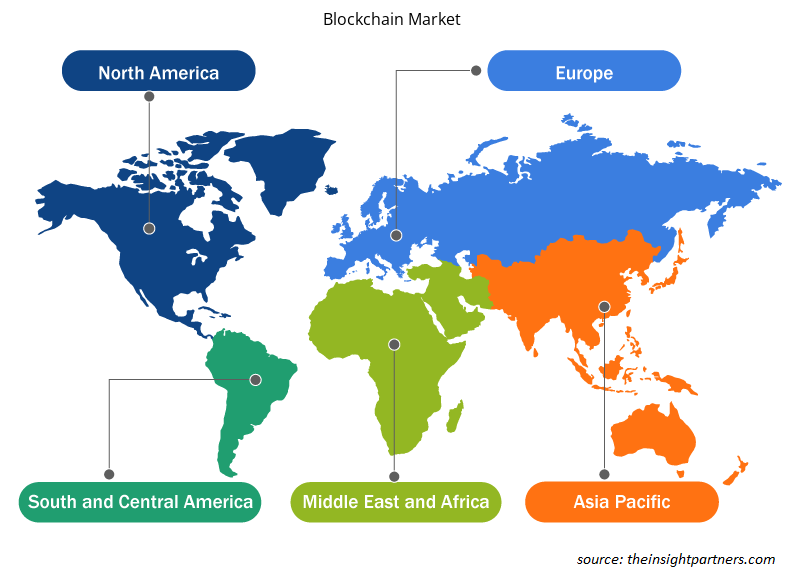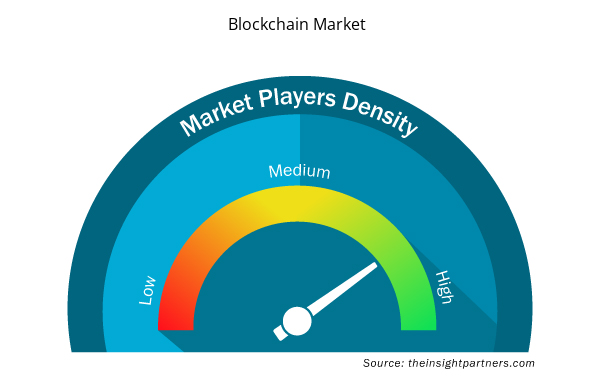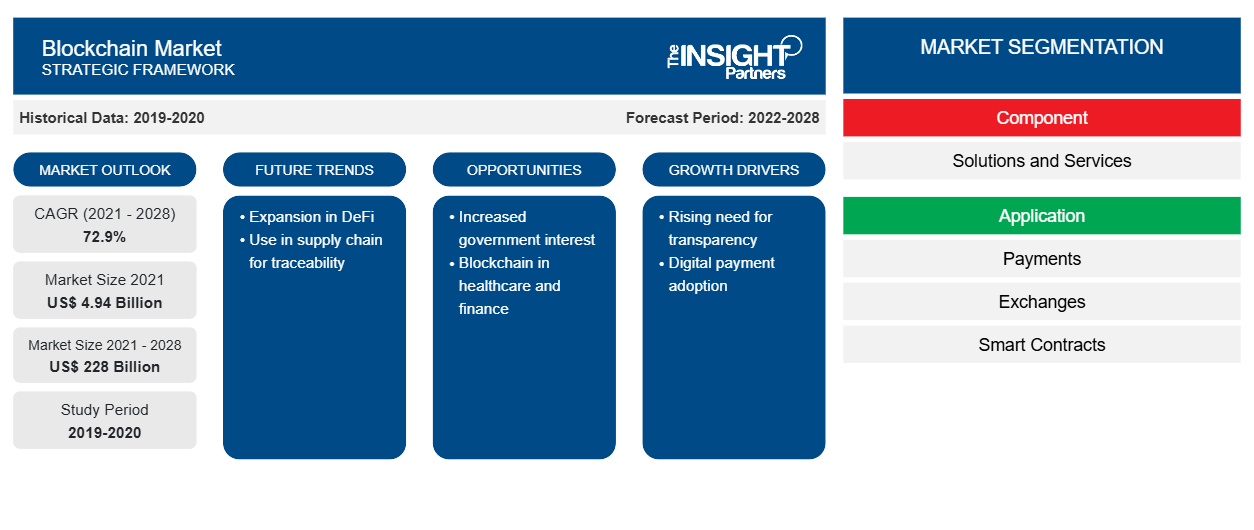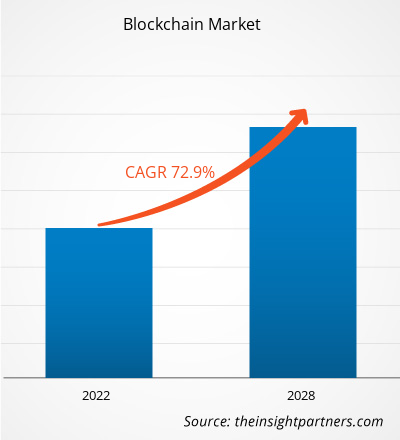Se espera que el mercado blockchain crezca de US$ 4.935,0 millones en 2021 a US$ 227.996,6 millones en 2028; se estima que crecerá a una CAGR del 72,9% entre 2021 y 2028.
La tecnología Blockchain y sus aplicaciones en el sector bancario, de servicios financieros y de seguros (BFSI) han atraído mucha atención en los últimos años, principalmente debido a su capacidad para transformar las bases y los modelos de negocio de las industrias existentes. En la actualidad, aparte de las aplicaciones de criptomonedas , las otras aplicaciones prácticas importantes de Blockchain siguen estando en el sector bancario y financiero; sin embargo, varias empresas e instituciones están desarrollando rápidamente soluciones basadas en Blockchain para resolver problemas empresariales complejos. En términos generales, Blockchain es un subconjunto de una tecnología de contabilidad distribuida (DLT) más amplia, y combina tres conceptos importantes: criptografía, contratos inteligentes y diseño de contabilidad distribuida. La tecnología de contabilidad distribuida (DLT) es un enfoque de rápido surgimiento que registra y comparte datos en varios almacenes de datos/libros mayores. La DLT facilita el registro, el intercambio y la sincronización de transacciones y datos en una red distribuida de diferentes participantes de la red.
Se prevé que el mercado global de blockchain presente un crecimiento muy alto en el futuro cercano. Los principales factores impulsores que contribuyen al crecimiento del mercado incluyen la amplia adopción de soluciones de blockchain en el sector BFSI; ventajas como mayor transparencia, mayor eficiencia operativa y ahorros sustanciales de costos; y un aumento en el número de nuevas empresas innovadoras. Durante el período de pronóstico, se espera que tendencias como el aumento del apoyo y las iniciativas gubernamentales y una combinación de blockchain e inteligencia artificial para aplicaciones avanzadas brinden oportunidades interesantes para los actores que operan en el mercado de blockchain.
Personalice este informe según sus necesidades
Obtendrá personalización en cualquier informe, sin cargo, incluidas partes de este informe o análisis a nivel de país, paquete de datos de Excel, así como también grandes ofertas y descuentos para empresas emergentes y universidades.
- Obtenga las principales tendencias clave del mercado de este informe.Esta muestra GRATUITA incluirá análisis de datos, desde tendencias del mercado hasta estimaciones y pronósticos.
Impacto de la pandemia de COVID-19 en el mercado de blockchain
Si bien la pandemia de COVID-19 ha planteado problemas importantes para las organizaciones de todo el mundo, el mercado de Blockchain ha crecido de manera constante durante la crisis. Lo más importante es que, a lo largo de la epidemia, los trabajadores de la salud han pasado a utilizar chats, correos electrónicos, teléfonos y conversaciones de video para tratar a los pacientes de forma remota, evitando que el virus se propague. El uso de herramientas de prueba de penetración para transacciones en línea seguras y datos conversacionales aumentó debido a esto. La adopción del mercado de Blockchain por parte de varias empresas para brindar una seguridad óptima durante un entorno caótico también es un elemento crucial que impulsa el mercado vertical de Blockchain. La pandemia de COVID-19 ha impactado todos los aspectos de la sociedad, incluidos los individuos y las corporaciones. El ecosistema de Internet se ha vuelto cada vez más importante a nivel mundial. La dependencia de las empresas en línea se ha expandido drásticamente debido al brote de COVID-19. Internet está siendo utilizado por BFSI, atención médica y ciencias biológicas, fabricación, venta minorista, transporte y logística, y otras industrias para brindar servicios críticos a los consumidores. La demanda de una Blockchain ha aumentado entre los proveedores. Diversos gobiernos y organismos reguladores han obligado a las organizaciones públicas y privadas a aceptar nuevas técnicas de teletrabajo y de preservación de la distancia social a raíz de la pandemia de COVID-19. Desde entonces, las prácticas comerciales digitales y el uso de correos electrónicos en servidores domésticos se han convertido en el nuevo plan de continuidad comercial (BCP) para una variedad de empresas.
Perspectivas del mercado de blockchain
Todas las principales industrias del mundo, incluidas las de banca, seguros, seguros y salud, comercio minorista, logística y transporte, atención médica, automotriz, medios y entretenimiento, y gobierno, están adoptando e invirtiendo en tecnologías disruptivas como blockchain, inteligencia artificial, Internet de las cosas (IoT), big data y análisis predictivo . La creciente adopción de la tecnología blockchain está impulsada por los casos de uso exitosos y la prueba de los conceptos de blockchain en varias industrias que resultaron en una mayor transparencia, una mayor eficiencia operativa y una reducción de costos. La naturaleza de las empresas se está volviendo muy competitiva en todas las industrias del mundo y, para competir de manera eficiente, las empresas hoy en día dependen de la integración de tecnología en varias funciones comerciales para aumentar la transparencia y la eficiencia operativas.
La tecnología Blockchain tiene varias aplicaciones en el sector financiero, incluidos los pagos, los mercados de capitales, los servicios comerciales, la gestión de inversiones y patrimonios y las bolsas de valores y materias primas. El importante ahorro de costes es uno de los principales impulsores de la creciente adopción de la tecnología Blockchain en este sector.
El uso de la tecnología Blockchain ha hecho que las transacciones sean más transparentes en las principales industrias. Esta transparencia ayuda a prevenir el fraude y las actividades no autorizadas en sectores como los servicios financieros, el gobierno y la atención médica, donde se comparten datos confidenciales entre los participantes. La tecnología Blockchain agiliza y automatiza los procesos tradicionales, que requieren mucho papeleo, consumen mucho tiempo y son propensos a errores humanos. Esto hace que las transacciones sean rápidas y eficientes, lo que aumenta la eficiencia operativa.
La reducción y el ahorro de costes son prioridades importantes para cualquier empresa. Blockchain elimina a terceros o intermediarios innecesarios para reducir tiempos y costes. Con todas estas ventajas, Blockchain permite a las empresas mejorar la eficiencia operativa, la transparencia, reducir los costes operativos y, por tanto, les ayuda a mejorar la calidad del servicio y la experiencia del cliente.
Información sobre segmentos de componentes
Según los componentes, el mercado de blockchain se puede dividir en servicios y soluciones. El segmento de soluciones lideró el mercado de blockchain. La creciente adopción de soluciones de blockchain debido a su capacidad para proporcionar más transparencia en la gestión de transacciones financieras en bitcoin, así como la creciente digitalización, está impulsando el mercado de blockchain hacia adelante. Los clientes pueden usar la plataforma de blockchain del mercado para crear entornos de blockchain privados, públicos y basados en consorcios y construir sus propias aplicaciones y soluciones de blockchain. Las personas, los productos, las aplicaciones y los servicios pueden interactuar a través de la red de blockchain, los proveedores de la nube y las empresas que utilizan estas plataformas.
Perspectivas regionales del mercado de blockchain
Los analistas de Insight Partners explicaron en detalle las tendencias y los factores regionales que influyen en el mercado de blockchain durante el período de pronóstico. Esta sección también analiza los segmentos y la geografía del mercado de blockchain en América del Norte, Europa, Asia Pacífico, Oriente Medio y África, y América del Sur y Central.

- Obtenga los datos regionales específicos para el mercado de blockchain
Alcance del informe sobre el mercado de blockchain
| Atributo del informe | Detalles |
|---|---|
| Tamaño del mercado en 2021 | 4.940 millones de dólares estadounidenses |
| Tamaño del mercado en 2028 | 228 mil millones de dólares estadounidenses |
| CAGR global (2021-2028) | 72,9% |
| Datos históricos | 2019-2020 |
| Período de pronóstico | 2022-2028 |
| Segmentos cubiertos | Por componente
|
| Regiones y países cubiertos | América del norte
|
| Líderes del mercado y perfiles de empresas clave |
|
Densidad de actores del mercado blockchain: comprensión de su impacto en la dinámica empresarial
El mercado de blockchain está creciendo rápidamente, impulsado por la creciente demanda de los usuarios finales debido a factores como la evolución de las preferencias de los consumidores, los avances tecnológicos y una mayor conciencia de los beneficios del producto. A medida que aumenta la demanda, las empresas amplían sus ofertas, innovan para satisfacer las necesidades de los consumidores y aprovechan las tendencias emergentes, lo que impulsa aún más el crecimiento del mercado.
La densidad de actores del mercado se refiere a la distribución de las empresas o firmas que operan dentro de un mercado o industria en particular. Indica cuántos competidores (actores del mercado) están presentes en un espacio de mercado determinado en relación con su tamaño o valor total de mercado.
Las principales empresas que operan en el mercado Blockchain son:
- Corporación IBM
- Corporación Microsoft
- Accenture
- Amazonas
- SAP SE
Descargo de responsabilidad : Las empresas enumeradas anteriormente no están clasificadas en ningún orden particular.

- Obtenga una descripción general de los principales actores clave del mercado Blockchain
Información sobre segmentos de aplicaciones
El mercado global de blockchain está segmentado en pagos, intercambios, contratos inteligentes, documentación, identidad digital, gobernanza, riesgo y cumplimiento, entre otros. El segmento de pagos lideró el mercado de blockchain. El segmento de otros incluye votación digital, viajes compartidos, publicidad y muchos otros. Blockchain reduce costos, aumenta la seguridad, aumenta la transparencia y disminuye el tiempo de transacción al tiempo que reduce la necesidad de un tercero confiable. Blockchain maneja un conjunto variado de reglas y configuraciones. Una aplicación como los contratos inteligentes puede mejorar en gran medida la eficiencia, confiabilidad y transparencia del proceso y reducir el riesgo. Los usos potenciales de blockchain son variados y amplios, y la tecnología se está volviendo más predominante.
Información sobre segmentos de tipo vertical de la industria
Blockchain es un libro de contabilidad distribuido capaz de verificar y registrar automáticamente un gran volumen de transacciones digitales, independientemente de la ubicación. A medida que las empresas emergentes utilizan la tecnología blockchain para impulsar una mayor transparencia en la red de información digital, aumentan la conciencia sobre la tecnología blockchain en varios sectores. Según la vertical de la industria, el mercado global de blockchain se clasifica en BFSI, comercio minorista, gobierno, transporte y logística, atención médica, automoción, medios y entretenimiento, y otros. El segmento otros incluye fabricación, bienes raíces, energía y servicios públicos, telecomunicaciones y deportes.
Los actores del mercado de blockchain se centran en la innovación y el desarrollo de nuevos productos mediante la integración de tecnologías y características avanzadas para competir. Por ejemplo, en 2019, Carrefour y Nestlé se asociaron con IBM para utilizar la tecnología blockchain en las categorías de alimentos. La asociación permitiría una rápida expansión de una red basada en blockchain que aporta más transparencia a la cadena de suministro mundial de alimentos de minoristas, productores, mayoristas, procesadores, distribuidores y fabricantes.
Mercado de blockchain: perfiles de empresas
- Corporación IBM
- Corporación Microsoft
- Accenture
- Amazonas
- SAP SE
- Desarrollo empresarial de Hewlett Packard LP (HPE)
- Corporación Oracle
- Corporación Intel
- Onda
- Grupo Bitfury
- Análisis histórico (2 años), año base, pronóstico (7 años) con CAGR
- Análisis PEST y FODA
- Tamaño del mercado Valor/volumen: global, regional, nacional
- Industria y panorama competitivo
- Conjunto de datos de Excel


- Electronic Shelf Label Market
- Playout Solutions Market
- Single-Use Negative Pressure Wound Therapy Devices Market
- Pressure Vessel Composite Materials Market
- Portable Power Station Market
- Power Bank Market
- Radiopharmaceuticals Market
- Long Read Sequencing Market
- Hummus Market
- Hydrogen Storage Alloys Market

Report Coverage
Revenue forecast, Company Analysis, Industry landscape, Growth factors, and Trends

Segment Covered
This text is related
to segments covered.

Regional Scope
North America, Europe, Asia Pacific, Middle East & Africa, South & Central America

Country Scope
This text is related
to country scope.
Preguntas frecuentes
Extensive Adoption of Blockchain Solutions in BFSI Industry Vertical
High Transparency and Operational Efficiency with Substantial Cost Savings
The rising Government Support and Initiatives Worldwide is anticipated to offer ample future growth opportunity to the Blockchain market solution providers over the forecast period of 2021 to 2028. The adoption of Blockchain technology is still in its nascent stages worldwide, and it is growing at different speeds in different geographies. The adoption of Blockchain in particular geography depends on government support and a favorable business environment. Blockchain technology has immense potential to transform businesses and government services. For sustainable growth of the Blockchain market, a unified regulatory framework is crucial, and it depends on the governments' will. The opportunities in various countries will grow exponentially depending on the supportive government initiatives worldwide. Various governments worldwide are coming at the forefront to help the fast adoption of Blockchain. For instance, the European Commission has recently supported signing a 27-country pact on Blockchain, known as the European Blockchain Partnership. This partnership will look into EU-wide collaboration on various regulatory and technical matters related to the Blockchain market. The EU is also planning to invest EUR 300 million in Blockchain over the next three years. On similar lines, the UAE in the Middle East has also formulated an ideal strategy for Blockchain. The focus of this strategy is to do 50% of all government transactions on Blockchain technology by 2021. Also, Sweden has announced its Blockchain-based land registry project. Moreover, the rising use cases of Blockchain in government applications is another positive sign for companies operating in this market. Some of the most common public sector use cases include digital identity, digital voting, inter & intragovernmental transactions, documentation records, and supply chain traceability. The most active governments adopting, investing, and exploring Blockchain include Japan, South Korea, Switzerland, Singapore, Australia, Russia, Canada, Chile, and the Republic of Georgia. All these examples of Blockchain use cases in the government sector and an increase in government support in various geographies are expected to provide ample opportunities to market players operating or planning to enter the Blockchain market
Key companies in the Blockchain market include IBM Corporation, Microsoft Corporation, Accenture, Amazon Web Services, SAP Se, Hewlett Packard Enterprise Development LP (HPE), Oracle Corporation, Intel Corporation, Ripple, and Bitfury Group.
The US is a significant contributor to the blockchain market in 2020. The US accounts for the largest market share in the blockchain market. The rapid evolution of blockchain technology is witnessing the developments of new platforms, partnerships, and applications in the country. Many companies in the U.S are collaborating with blockchain startups and some of the large players. Also, with the increased digitalization of business, maintaining trust can become expensive, inefficient, and time-consuming. Blockchain improves the reliability of data and reduced chances of fraud. These factors would fuel the demand of blockchain technology in the U.S.
Based on component, the global Blockchain market is segmented into Services, and Solution. The solution segment led the Blockchain market with a market share of 67.2% in 2020. It is expected to account for 69.1% of the total market in 2028.
Artificial intelligence (AI) and its applications such as machine learning and deep learning have grown tremendously over the last few years. AI is being utilized extensively in numerous areas, ranging from cloud computing applications to digital assistants and self-driving/autonomous vehicles. With some of the most prominent tech players from the US and China, such as Google, Amazon, Apple, Facebook, Microsoft, IBM, Baidu, Alibaba, and Tencent, at the forefront of artificial intelligence research and development, this technology is expected to change the face of every industry in the coming future. Blockchain technology and Artificial intelligence are two breakthrough technologies, and they work very well in unison. Combining these two technologies helps build and organize massive databases, strengthen various cybersecurity protocols, and perform tasks in less time than humans. Artificial intelligence works on the data gathered from multiple sources to extract valuable insights related to various business processes and customer preferences while saving costs and increasing operational efficiency for companies. Using AI to collect information is the most common way to use artificial intelligence technology. This data collection and its ethical use pose difficulties in the wide adoption of AI. In this matter, Blockchain can help by storing the AI mechanisms that process data on a distributed and decentralized registry which will help in securing personal information. In Blockchain, users can determine themselves who should be given access to their personal information by using private and public keys. Artificial intelligence-powered blockchains can provide decentralized identification to protect user identity. Various companies are using Blockchain and AI together in diverse applications. For instance, VIA uses Blockchain and AI to help large energy companies conceptualize and use their data more effectively. AlphaNetworks is a Blockchain-powered entertainment platform that uses Artificial Intelligence to improve audience analytics and viewership algorithms. NetObjex is a smart city infrastructure platform that uses Blockchain, IoT, and AI to power connected devices and cloud-based products.
Trends and growth analysis reports related to Banking, Financial Services, and Insurance : READ MORE..
The List of Companies - Blockchain Market
- IBM Corporation
- Microsoft Corporation
- Accenture
- Amazon
- SAP SE
- Bitfury Group Limited
- Ripple Labs Inc.
- Hewlett Packard Enterprise Development LP (HPE)
- Oracle Corporation
- Intel Corporation
The Insight Partners performs research in 4 major stages: Data Collection & Secondary Research, Primary Research, Data Analysis and Data Triangulation & Final Review.
- Data Collection and Secondary Research:
As a market research and consulting firm operating from a decade, we have published and advised several client across the globe. First step for any study will start with an assessment of currently available data and insights from existing reports. Further, historical and current market information is collected from Investor Presentations, Annual Reports, SEC Filings, etc., and other information related to company’s performance and market positioning are gathered from Paid Databases (Factiva, Hoovers, and Reuters) and various other publications available in public domain.
Several associations trade associates, technical forums, institutes, societies and organization are accessed to gain technical as well as market related insights through their publications such as research papers, blogs and press releases related to the studies are referred to get cues about the market. Further, white papers, journals, magazines, and other news articles published in last 3 years are scrutinized and analyzed to understand the current market trends.
- Primary Research:
The primarily interview analysis comprise of data obtained from industry participants interview and answers to survey questions gathered by in-house primary team.
For primary research, interviews are conducted with industry experts/CEOs/Marketing Managers/VPs/Subject Matter Experts from both demand and supply side to get a 360-degree view of the market. The primary team conducts several interviews based on the complexity of the markets to understand the various market trends and dynamics which makes research more credible and precise.
A typical research interview fulfils the following functions:
- Provides first-hand information on the market size, market trends, growth trends, competitive landscape, and outlook
- Validates and strengthens in-house secondary research findings
- Develops the analysis team’s expertise and market understanding
Primary research involves email interactions and telephone interviews for each market, category, segment, and sub-segment across geographies. The participants who typically take part in such a process include, but are not limited to:
- Industry participants: VPs, business development managers, market intelligence managers and national sales managers
- Outside experts: Valuation experts, research analysts and key opinion leaders specializing in the electronics and semiconductor industry.
Below is the breakup of our primary respondents by company, designation, and region:

Once we receive the confirmation from primary research sources or primary respondents, we finalize the base year market estimation and forecast the data as per the macroeconomic and microeconomic factors assessed during data collection.
- Data Analysis:
Once data is validated through both secondary as well as primary respondents, we finalize the market estimations by hypothesis formulation and factor analysis at regional and country level.
- Macro-Economic Factor Analysis:
We analyse macroeconomic indicators such the gross domestic product (GDP), increase in the demand for goods and services across industries, technological advancement, regional economic growth, governmental policies, the influence of COVID-19, PEST analysis, and other aspects. This analysis aids in setting benchmarks for various nations/regions and approximating market splits. Additionally, the general trend of the aforementioned components aid in determining the market's development possibilities.
- Country Level Data:
Various factors that are especially aligned to the country are taken into account to determine the market size for a certain area and country, including the presence of vendors, such as headquarters and offices, the country's GDP, demand patterns, and industry growth. To comprehend the market dynamics for the nation, a number of growth variables, inhibitors, application areas, and current market trends are researched. The aforementioned elements aid in determining the country's overall market's growth potential.
- Company Profile:
The “Table of Contents” is formulated by listing and analyzing more than 25 - 30 companies operating in the market ecosystem across geographies. However, we profile only 10 companies as a standard practice in our syndicate reports. These 10 companies comprise leading, emerging, and regional players. Nonetheless, our analysis is not restricted to the 10 listed companies, we also analyze other companies present in the market to develop a holistic view and understand the prevailing trends. The “Company Profiles” section in the report covers key facts, business description, products & services, financial information, SWOT analysis, and key developments. The financial information presented is extracted from the annual reports and official documents of the publicly listed companies. Upon collecting the information for the sections of respective companies, we verify them via various primary sources and then compile the data in respective company profiles. The company level information helps us in deriving the base number as well as in forecasting the market size.
- Developing Base Number:
Aggregation of sales statistics (2020-2022) and macro-economic factor, and other secondary and primary research insights are utilized to arrive at base number and related market shares for 2022. The data gaps are identified in this step and relevant market data is analyzed, collected from paid primary interviews or databases. On finalizing the base year market size, forecasts are developed on the basis of macro-economic, industry and market growth factors and company level analysis.
- Data Triangulation and Final Review:
The market findings and base year market size calculations are validated from supply as well as demand side. Demand side validations are based on macro-economic factor analysis and benchmarks for respective regions and countries. In case of supply side validations, revenues of major companies are estimated (in case not available) based on industry benchmark, approximate number of employees, product portfolio, and primary interviews revenues are gathered. Further revenue from target product/service segment is assessed to avoid overshooting of market statistics. In case of heavy deviations between supply and demand side values, all thes steps are repeated to achieve synchronization.
We follow an iterative model, wherein we share our research findings with Subject Matter Experts (SME’s) and Key Opinion Leaders (KOLs) until consensus view of the market is not formulated – this model negates any drastic deviation in the opinions of experts. Only validated and universally acceptable research findings are quoted in our reports.
We have important check points that we use to validate our research findings – which we call – data triangulation, where we validate the information, we generate from secondary sources with primary interviews and then we re-validate with our internal data bases and Subject matter experts. This comprehensive model enables us to deliver high quality, reliable data in shortest possible time.


 Obtenga una muestra gratuita de este informe
Obtenga una muestra gratuita de este informe